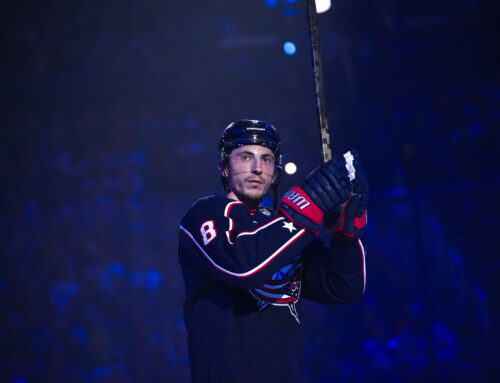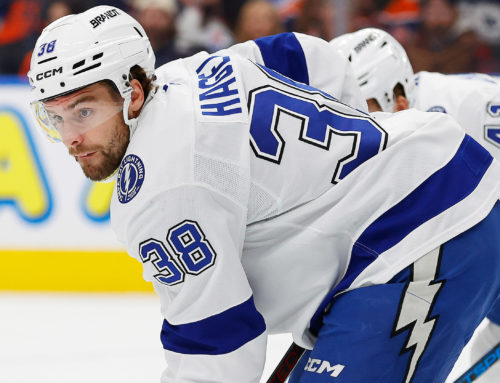Keeping with the theme of recent weeks, we are going to do a bit of a dive into one specific area this week. Today the topic is goal scoring and how we can use connected data points to make better informed decisions about player performance.
To address goal scoring we are going to rely on two stats: shooting percentage and shot rate. It is pretty standard fare to look at shooting percentage for a player and make an assessment as to whether or not that percentage is inflated or depressed and then make an educated guess about where it might go in the future. This week I wanted to add the context of a player's shot rate.
The reason to add shot rate is that it can be somewhat of a mitigating, or exacerbating, factor in any changes to player performance. Let's take a basic example. We have two players scoring at a 20-goal pace. They both typically shoot at a 10% rate, but are experiencing very different amounts of luck. One is shooting at 5%, and the other 15%. We expect regression to hit both players but the literal amount of goals we expect each to change is dramatically different.
A player who is on a 20-goal pace and shooting five percent is on pace for 400 shots. While a player who is on a 20-goal pace but shooting 15 percent is on pace for 133 shots. If both revert back to their average, player one jumps up to a 40-goal pace (a difference of 20 goals) and player two reverts to a 13(ish)-goal pace, a change of seven goals. Additionally, if the swing were to continue and player one gets the good luck they are up at a 60 goal pace, while player two getting back luck is down at about six goals – so basically not relevant.
The goal for today is then to look for players with a high volume of shots who are scoring at a lower rate than average, and therefore are most likely to see the largest increase in total goal production, and also find those players who are not shooting a lot but have a high shooting percentage who could completely fall off the map if that shooting luck regresses.
For process here I pulled the Shots report from Frozen Tools and grabbed the first few columns since I was most interested in overall shooting percentage and shot rate. The report does go further to break items down by shot rate per game state, which can also be incredibly helpful. I added a per game metric to get a more comparable shot count and a three-year shooting percentage average to get an idea whether or not a player was doing better or worse than their usual.
First up: players who are shooting a lot but have a low (for them) shooting percentage. These are players that maybe haven’t been hit teams quite as hard as the volume of shooting has made up for the lackluster shooting percentage, but stand to gain a lot if they return to personal average levels.
| Name | Pos | Team | GP | G | SOG | SOG/G | S% | 3 Season S% | Δ |
| NATHAN MACKINNON | C | COL | 35 | 13 | 187 | 5.34 | 7 | 10.6 | -3.6 |
| AUSTON MATTHEWS | C | TOR | 47 | 25 | 200 | 4.26 | 12.5 | 17.2 | -4.7 |
| EVANDER KANE | R | EDM | 17 | 5 | 63 | 3.71 | 7.9 | 12.5 | -4.6 |
| NIKITA KUCHEROV | R | T.B | 46 | 19 | 164 | 3.57 | 11.6 | 15.8 | -4.2 |
| ALEX DEBRINCAT | L | OTT | 47 | 15 | 162 | 3.45 | 9.3 | 14.4 | -5.1 |
Not a lot of actionable advice here around Auston Matthews, Nathan MacKinnon, or Nikita Kucherov. They are highly rostered superstars that most folks won't be parting with, though it is nice to know (if you roster them) that a regression would mean better scoring.
Evander Kane is currently hampered by the emergence of Zach Hyman and there are rumors that he has returned without being completely 100% so he certainly bears watching, but I wanted to focus on Alex DeBrincat here.
DeBrincat is fresh off a 40-goal season with Chicago and moving to Ottawa seems to have raised a few question marks. He is currently on a 25-goal pace, a pretty steep drop from 21-22. His player profile is interesting. DeBrincat is on this list as he is off his usual shooting percentage, that big a drop (in the absence of other data) would be expected to right itself. We also see that he is down in overall ice time in Ottawa, though that seems to be predominately in short-handed time, and he is actually seeing a bit more time on the power-play. So that seems fine. His shot rates are fine as well. Like his personal shooting percentage though, his even-strength team shooting percentage is also down indicating he and his teammates are not shooting well (which we already knew about him). Again, this is an area where we would normally expect some positive regression – so more goals in the future for him and his linemates. The problem here is that his expected goal numbers are way down. The implication being that though he is shooting his normal amount, those chances are much much less dangerous. Given that it isn't too surprising then that his personal and team shooting percentages are lower than expected. Overall, he certainly bears watching. There are a number of items that we would usually look at and say he should likely rebound, but it is concerning that his expected goal numbers are so low.
And now on to the reverse. These are players who are shooting at very high percentages, but with a very low volume. The result could be a significant reduction, or dry spell for these players.
| Name | Pos | Team | GP | G | SOG | SOG/G | S% | 3 Season S% | Δ |
| NICHOLAS PAUL | C | T.B | 46 | 16 | 75 | 1.63 | 21.3 | 8 | 13.3 |
| JARED MCCANN | R | SEA | 44 | 23 | 90 | 2.05 | 25.6 | 12.4 | 13.2 |
| RYAN NUGENT-HOPKINS | C | EDM | 49 | 22 | 115 | 2.35 | 19.1 | 10.6 | 8.5 |
| VICTOR OLOFSSON | R | BUF | 47 | 22 | 106 | 2.26 | 20.8 | 12.6 | 8.2 |
| FILIP CHYTIL | C | NYR | 40 | 15 | 87 | 2.18 | 17.2 | 9.2 | 8 |
| NICK SUZUKI | C | MTL | 48 | 16 | 87 | 1.81 | 18.4 | 11.3 | 7.1 |
| RYAN DONATO | L | SEA | 40 | 12 | 70 | 1.75 | 17.1 | 10.1 | 7 |
I am not sure there is a lot more to add specifically for most of these players. I think overall the ones that stand out for me the most are Jared McCann and Ryan Donato. The Kraken are continually ranking very highly on the lists of goals scored above expected and McCann and Donato are certainly big parts of that. For Donato's part, his inconsistent role in the lineup is a major concern as when the team is healthy, he is often a healthy scratch. For McCann he is somehow doing this with essentially all even strength production. That is one possibly mitigating factor for him. If he can transfer his relatively unsustainable even strength production to the power-play where he is underperforming a bit he might be able to recapture some of the lost goal production here.
That is all for this week
Do your part to support organizations working to make hockey for everyone.





 EDM
EDM FLA
FLA MIN
MIN BUF
BUF CAR
CAR DET
DET TOR
TOR DAL
DAL S.J
S.J
